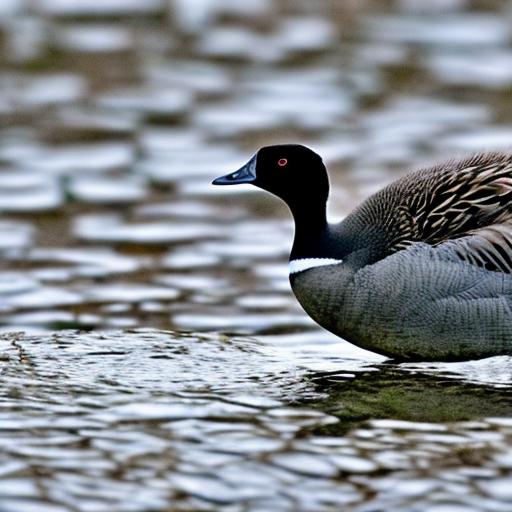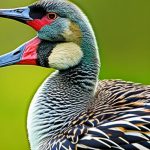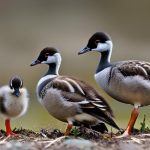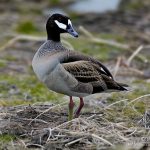Canada Geese are a familiar sight in the UK, with their distinctive black heads and necks, white chinstrap, and brown bodies. These large waterfowl are native to North America, but have established populations in the UK, where they are a common sight in parks, lakes, and other bodies of water. Canada Geese are known for their V-shaped flying formations and their loud honking calls, which can be heard from a distance. They are a popular species for birdwatchers and nature enthusiasts, and their presence adds to the diversity of wildlife in the UK.
Canada Geese are migratory birds, and their presence in the UK is largely due to their annual migration patterns. They breed in the northern parts of North America during the summer months, and then migrate south to warmer climates for the winter. Some Canada Geese have established year-round populations in the UK, while others visit during the winter months. Their migration patterns and nesting habits make them an interesting species to study and observe in the UK.
The Migration Patterns of Canada Geese
Canada Geese are known for their impressive migration patterns, which can cover thousands of miles each year. In the UK, Canada Geese can be found in both resident populations and migratory populations. Resident populations are those that have established year-round habitats in the UK, while migratory populations visit the UK during the winter months. The migration patterns of Canada Geese are influenced by a variety of factors, including weather, food availability, and breeding habits.
During the summer months, Canada Geese breed in the northern parts of North America, where they build nests and raise their young. As the weather begins to cool in the fall, Canada Geese begin their migration south, traveling in large flocks to warmer climates. Some Canada Geese travel as far south as Mexico, while others stop in the UK and other parts of Europe. The migration patterns of Canada Geese are a marvel of nature, and studying their movements can provide valuable insights into their behavior and ecology.
The Ideal Nesting Locations for Canada Geese in the UK
Canada Geese are known for their adaptability and can be found in a variety of habitats in the UK, including lakes, rivers, ponds, and coastal areas. When it comes to nesting, Canada Geese have specific preferences for the ideal locations to build their nests. They prefer nesting sites that are near water, as this provides protection from predators and easy access to food. In the UK, Canada Geese can be found nesting in a variety of locations, including parks, golf courses, and nature reserves.
Canada Geese build their nests on the ground, typically near water, and use a variety of materials, including grass, twigs, and feathers. They are known for their territorial behavior and will defend their nesting sites from other geese and potential threats. The ideal nesting locations for Canada Geese in the UK are those that provide a combination of safety, food availability, and suitable nesting materials. Understanding the nesting preferences of Canada Geese can help conservationists and wildlife managers protect their nesting sites and ensure the survival of their populations in the UK.
The Nesting Habits and Behaviors of Canada Geese
Canada Geese are monogamous birds and form strong pair bonds with their mates. They are known for their elaborate courtship displays, which involve head bobbing, honking, and wing flapping. Once a pair has formed, they will search for a suitable nesting site and begin building their nest. Canada Geese are highly territorial during the nesting season and will aggressively defend their nests from other geese and potential threats.
The nesting habits and behaviors of Canada Geese are fascinating to observe and study. They are attentive parents and will fiercely protect their eggs and young from predators. Canada Geese typically lay a clutch of 4-6 eggs, which are incubated for around 25-30 days. Once the eggs hatch, the goslings are cared for by both parents and will stay with them until they are old enough to fly. Understanding the nesting habits and behaviors of Canada Geese is important for conservation efforts and can help ensure the survival of their populations in the UK.
The Importance of Canada Geese Nesting Sites in the UK
Canada Geese play an important role in the ecosystem of the UK, and their nesting sites are crucial for their survival. Nesting sites provide a safe and secure location for Canada Geese to raise their young, away from predators and other threats. They also provide access to food and water, which are essential for the health and well-being of the geese and their offspring. In addition, Canada Geese nesting sites contribute to the biodiversity of the UK and provide opportunities for people to observe and appreciate these magnificent birds.
The importance of Canada Geese nesting sites in the UK cannot be overstated. Protecting and preserving these sites is essential for the long-term survival of Canada Geese populations in the UK. Nesting sites provide a critical habitat for Canada Geese and contribute to the overall health of the ecosystem. By understanding the importance of nesting sites, conservationists and wildlife managers can develop strategies to protect and manage these areas for the benefit of Canada Geese and other wildlife in the UK.
Challenges and Threats to Canada Geese Nesting in the UK
Despite their adaptability, Canada Geese face a number of challenges and threats to their nesting sites in the UK. One of the biggest threats is habitat loss and degradation, as urban development and human activities encroach on their natural habitats. Pollution and water quality issues can also impact the suitability of nesting sites for Canada Geese. In addition, predation by foxes, crows, and other animals can pose a significant threat to Canada Geese nests and their young.
Climate change is another major challenge facing Canada Geese nesting sites in the UK. Changes in weather patterns and rising sea levels can impact the availability of suitable nesting sites and food sources for Canada Geese. Invasive species and competition for resources from other bird species can also pose a threat to Canada Geese nesting sites. Understanding the challenges and threats facing Canada Geese nesting sites is essential for developing effective conservation strategies to protect and preserve these important habitats in the UK.
Conservation Efforts to Protect Canada Geese Nesting Sites
Conservation efforts to protect Canada Geese nesting sites in the UK are essential for the long-term survival of these magnificent birds. Wildlife organizations, government agencies, and local communities are working together to develop and implement strategies to protect and manage nesting sites for Canada Geese. These efforts include habitat restoration, water quality improvement, and the creation of protected areas for nesting and breeding.
Conservationists are also working to raise awareness about the importance of Canada Geese nesting sites and the threats they face. Education and outreach programs are helping to engage the public in conservation efforts and promote responsible stewardship of natural resources. By working together, conservationists and local communities can make a positive impact on the conservation of Canada Geese nesting sites in the UK.
The Role of Canada Geese in the UK Ecosystem
Canada Geese play a vital role in the ecosystem of the UK, and their presence has a number of positive impacts on the environment. As herbivores, Canada Geese help to control the growth of aquatic vegetation in lakes and ponds, which can improve water quality and create habitat for other wildlife. Their droppings also contribute to nutrient cycling and can help fertilize the soil, promoting the growth of plants and supporting a diverse range of species.
In addition, Canada Geese are an important part of the food web in the UK, providing a food source for predators such as foxes, eagles, and other birds of prey. Their presence also contributes to the overall biodiversity of the UK and provides opportunities for people to observe and appreciate these magnificent birds. Understanding the role of Canada Geese in the UK ecosystem is essential for developing effective conservation strategies and ensuring the long-term health of the environment.
Human Interaction with Canada Geese Nesting Sites
Human interaction with Canada Geese nesting sites in the UK can have both positive and negative impacts on their populations. While many people enjoy observing and appreciating Canada Geese, human activities can also pose a threat to their nesting sites. Disturbance from people, pets, and recreational activities can disrupt nesting behavior and cause Canada Geese to abandon their nests. Feeding Canada Geese can also lead to overpopulation and the spread of disease, which can impact the health of their populations.
On the other hand, responsible human interaction with Canada Geese nesting sites can help support their conservation and protection. By respecting nesting areas, keeping a safe distance from nesting geese, and avoiding feeding them, people can help minimize disturbance and promote the well-being of Canada Geese populations in the UK. Education and outreach programs can also help raise awareness about the importance of responsible stewardship and the impact of human activities on Canada Geese nesting sites.
Future Outlook for Canada Geese Nesting in the UK
The future outlook for Canada Geese nesting in the UK depends on the success of conservation efforts and the ability to address the challenges and threats they face. By working together to protect and manage nesting sites, conservationists, government agencies, and local communities can help ensure the long-term survival of Canada Geese populations in the UK. Habitat restoration, water quality improvement, and the creation of protected areas are essential for providing safe and secure nesting sites for Canada Geese.
In addition, raising awareness about the importance of Canada Geese nesting sites and the threats they face can help engage the public in conservation efforts and promote responsible stewardship of natural resources. By understanding the role of Canada Geese in the UK ecosystem and the impact of human activities on their populations, people can make a positive impact on the conservation of these magnificent birds. With continued dedication and collaboration, the future outlook for Canada Geese nesting in the UK is promising, and their presence will continue to enrich the biodiversity and natural beauty of the UK.
Meet Walter, the feathered-friend fanatic of Florida! Nestled in the sunshine state, Walter struts through life with his feathered companions, clucking his way to happiness. With a coop that’s fancier than a five-star hotel, he’s the Don Juan of the chicken world. When he’s not teaching his hens to do the cha-cha, you’ll find him in a heated debate with his prized rooster, Sir Clucks-a-Lot. Walter’s poultry passion is no yolk; he’s the sunny-side-up guy you never knew you needed in your flock of friends!







